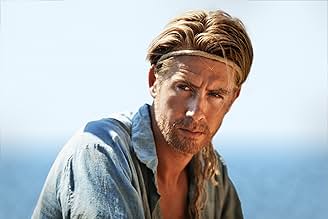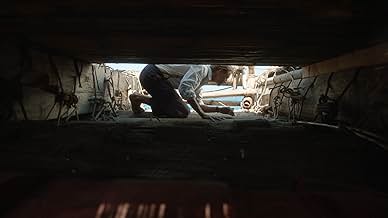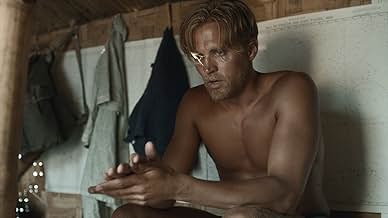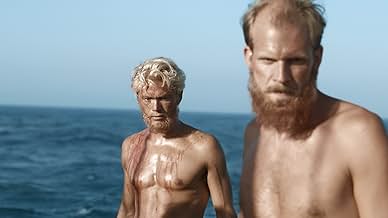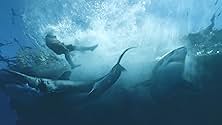Nel 1947, l'esploratore leggendario Thor Heyerdal ha attraversato il Pacifico per sette mila chilometri su una zattera, nel tentativo di dimostrare che era possibile che i sudamericani si st... Leggi tuttoNel 1947, l'esploratore leggendario Thor Heyerdal ha attraversato il Pacifico per sette mila chilometri su una zattera, nel tentativo di dimostrare che era possibile che i sudamericani si stabilissero in Polinesia in epoca precolombiana.Nel 1947, l'esploratore leggendario Thor Heyerdal ha attraversato il Pacifico per sette mila chilometri su una zattera, nel tentativo di dimostrare che era possibile che i sudamericani si stabilissero in Polinesia in epoca precolombiana.
- Regia
- Sceneggiatura
- Star
- Candidato a 1 Oscar
- 12 vittorie e 14 candidature totali
- Thor Heyerdahl
- (as Pål Hagen)
- Herman Watzinger
- (as Anders Baasmo Christiansen)
- Thor 6 yrs.
- (as Kasper Ameberg Johnsen)
Recensioni in evidenza
The film began with Thor as a child when he fell into the icy lake and almost drowned. However we later find out that that accident and his inability to swim did not deter his adventurous spirit. We fast forward to Thor and his wife Liv on Fatu Hiva, a Polynesian island, in 1937. There he learned the belief of the islanders that their ancestor Tiki actually came from the East (the Americas) instead of Asia as commonly assumed.
For several years, Thor tried to get his theory about Polynesian origins published but was repeatedly rejected. Therefore, he resolved to prove his theory by recreating Tiki's original ocean journey from Peru to Polynesia on a raft made of balsa wood (with strictly no modern materials).
It is just too coincidental that I am watching another ocean adventure just a few days after watching "Life of Pi." Kon-Tiki traveled the Pacific in the opposite direction that Pi did. It had an experienced though spare crew of 5, composed of two sailors, an engineer, an ethnographer and Thor, so it had a distinct advantage over the teenager and a tiger.
But maybe because I just watched Pi, maybe I expected to see so much more maritime misfortune than I did with Kon-Tiki. However, that sequence with vicious sharks had real heart-stopping suspense. I do have some misgivings about that episode with the whale shark, because it is not really the aggressive creature depicted in the film.
This was a straight-forward adventure film for the family. It may seem old-fashioned to some, nothing too controversial or strange as one can expect from modern European cinema. It was by no means boring, but I admit I felt like it lacked a certain edge while I was watching it. The crew members did not even have any significant conflict among each other and they were trapped on a raft for a hundred days! That may come across as unbelievable in these days of Big Brother and other "reality" TV shows.
I do hope I can find myself a copy of the 1950 Oscar-winning documentary about the real Thor Heyerdahl, his crew and their 101-day oceanic ordeal. That should be very interesting indeed.
This is the story about the amazing world famous Kon-Tiki trip crossing the pacific on a balsa-raft just to prove this happened in ancient times, made by the makers of great Max Manus.
The trip, taken on the basis of an idea of the explorer Thor Heyerdahl, was completely ludicrous and no one believed it could be done. and how could a trip like this be told better than by Heyerdahl himself in the documentary made during the trip.
Back in 1947 this was just the story the world wanted to be told after the 2nd world war and the atomic bombings of Hiroshima and Nagasaki. The documentary film from the trip later won Oscar (1951), and the book was translated into 70 languages, and sold more than 50 million copies world wide.
Finally we get to see the trip dramatized as it should be. And the result is really an amazing and epic film which holds two hours of explorer-ism, excitement and awe. I think we really get to imagine how it was to be 6 persons floating on an uncontrollable raft in the middle of nowhere for more than hundred days. The bore, the awe of discoveries, the fear of weather, sharks and whales. The psychological toll, the friendship...
It's a great story and a great film which will make new generations pick up the book with the same name, before they watch the original documentary. Beautifully filmed, well played, even down to Heyerdahl incredibly bad English pronunciation. Not all is accurate. There's been a debate around the premiere about making Herman Watzinger such a wimpy character, when we actually was a Norwegain 100 m record holder and a strong guy with good looks, but the writers found the story needed heart, and not only bald and crazy feeling-less young men. I agree. Over 100 days on a raft is at least 90 days of boredom.
Thor Heyerdahl himself made this trip to prove his idea, which no one would believe, and later got famous. He made the trip though he was not only not able to swim, but actually afraid of water, can you imagine! And it also tells the story of those left behind, wife and kids.
This is the most expensive Norwegian film production ever, and the story is a Norwegian sacred explorers story, as good as they come, changing world history. Thankfully the film floats as good as the raft, and is well wort ha watch. Great manuscript, beautifully filmed, good handcraft.
The film comes in both a Norwegian and an international (English) spoken version, which gives the movie a possibility to be shown all over the world. And it will. Treat yourself to an insane, but epic trip, and get to be an explorer yourself. This is great storytelling! It loses one of 10 stars due to the irritating (though factual) English pronunciation of Heryerdahl. Not necessary to re-experience that to make a good story.
*** (out of 4)
Visually stunning telling of explorer Thor Heyerdahl's (Pal Sverre Hagen) epic and now legendary journey traveling nearly 5,000 miles from Peru to Polynesia in a wooden raft. Directors Joachim Ronning and Espen Sandberg certainly do a marvelous job in bringing this story to the screen, although I think the screenplay at times could have given more information than what we're just seeing. I think a little more character development might have helped the film somewhat but there's still no question that this here is mighty impressive and especially considering the budget. I think the best thing in the film is the wonderful visuals and right from the start they just leap right off the screen. Whether it's the snowy landscape of Norway or the beautiful blues of the sea, the look of this movie is something that makes you just want to pause the film and admire its beauty. The cinematography is top-notch and I'd argue some of the best that I've seen in recent years. The cinematography certainly helps grab all of these beautiful images but I also think it's so good that it also takes the viewer and places them directly on the boat to experience everything that happens. As for the real story, seeing it unfold here makes for a thrilling adventure that deals with some bickering between the men but also some breathtaking moments involving a whale and some highly intense scenes with sharks. The acting is another major plus as all the key people do a wonderful job in the film even while none of their characters really jump out at you except for the lead. The film is certainly very uplifting and inspirational and it really makes you respect these explorers for everything they did and of course their bravery. This film is certainly a fitting tribute to the men who went on this mission.
Beautiful cinematography...including magnificent scenes of whales & sharks circling the raft.
Character studies of Thor Heyerdahl & his companions on the journey are intelligent subtle portrayals. Thor is one driven man, from almost drowning in childhood to landing on the beach on Roraia, Indonesia. Thor spent ten years with his theory that Polynesia was settled from Peru; not from Asia, the settled hypothesis at the time. Final proof came via the 1947 voyage on a raft using the same 1500 year old techniques of navigation and raft construction. While this may sound a bit dry, it is not. The passion of the participants is palpable. Each has their own reason for going on the journey; most simply falling under Heyerdahl's charisma. (Heyerdahl's 1950 documentary won the Academy Award, and remains the only Norwegian winner of an Academy Award to date.)
Though not cast based simply on physical looks (per the co-directors), several are magnificent specimens of blond 1940s fit men...and their bonding.
Every scene was filmed first in Norwegian, then in English; (US release of the English version seen is expected by the Weinstein group later in 2013.) Filming was 59 days in six countries. Audience reaction of the PSIFF screening was loudly appreciated followed with Q&A with the co-directors.
If nothing else, Kon-Tiki (the name of the aforementioned vessel) adds to the impressive list of superb films from Scandinavia this past year. From Headhunters (one of my favourites of 2012) to the overlooked Snabba cash (Easy Money), fare from this region has never been more accessible or memorable.
So now comes Kon-Tiki, the first Norwegian film to score both a nomination at the Golden Globe and Academy Award ceremonies, and it's rather easy to see why. This sweeping journey appeals squarely to Hollywood sensibilities, twisting up an epic, historical adventure about overcoming the odds, with human drama. Though this intentional slanting may take some of the complexity and grit out of the film in the end, praise is abundantly deserved for all those involved.
Chief on that list is filmmaking duo Joachim Rønning and Espen Sandberg, best known previously for the Luc Besson-produced Bandidas with Penelope Cruz and Selma Hayek, who craft something lavish and visually sumptuous out of this trek, despite the hurdle of being endowed with a budget of just $16 million.
By recreating Heyerdahl's raft, shooting out over the deep and using special effects only as infrequent enhancements rather than a crutch, these two lay the authenticity on thick and in doing so generate tension and wonder (sometimes simultaneously) like you wouldn't imagine. Kon- Tiki, though never overtly stealing, mirrors the most effective aspects of films like Cast Away, Jaws and Mutiny on the Bounty.
When Rønning and Sandberg aren't capturing sweeping, stunning shots of the Pacific (and the tiny boat at its mercy) they are letting the camera rest on the diminutive aspects of the voyage, at least so when compared to the grandness of what's around them. The ropes lashing together the massive balsa wood beams strain and groan in the water, summoning us back to an earlier scene where two sailors warn Heyerdahl that a raft of that nature will inevitably break apart with the movement of the logs. Sharks silently circle and the boat slowly crumbles as the wood absorbs seawater. These quiet moments are as unnerving as anything you'll see on the big screen.
Likewise, there are grander, more elaborate moments that drip with tension all the same, as when storms hit, men are cast overboard, and once again sharks, though proving to be one of the lesser threats in the scheme of things, use their mythos alone to chill to the bone. If not as complex as it could have been, Kon-Tiki is certainly never dull.
The cast of unknown actors are also strong, even if by the time the credits role their sporting of Grizzly Adams-like beards makes identifying between some of these brave men difficult. Leading the way as the driven Heyerdahl is – wait for this one – Pål Sverre Valheim Hagen, anchoring (no pun intended) the film as a man intent on proving his settlement theory to sceptical scholars. Joining him is engineer (and refrigerator salesman) Herman Watzinger (Anders Baasmo Christiansen) navigator Erik Hesselberg (Odd Magnus Williamson) ethnographer Bengt Danielsson (Gustaf Skarsgård) and two soldiers acting as radio men Knut Haugland and Torstein Raaby (Tobias Santelmann and Jakob Oftebro respectively).
Together, crammed together like sardines, they make the 101-day journey, each bringing not only their respective skill-sets but demons as well. Those versed in Heyerdahl's novel or the documentary of the voyage (the winner of the 1950 Oscar for Best Documentary Feature) may cry afoul at some of the changes that have been made in service to crafting a more dramatic effort, particularly tweaks to the Watzinger character, but they will in no way impact how most will respond to Kon-Tiki.
Though not as weighty or viscerally lasting as some fare that pops up in the Best Foreign Language Film category, it is, however, infinitely accessible to anyone who usually turns their nose up at that particular segment of the ceremony. Kon-Tiki is a strong import, fascinating and thrilling in equal measure and a film that is just as much about the perils of nature as it is about the gratification that comes with conquering it.
Lo sapevi?
- QuizLarge parts of the film were filmed in two versions at the same time, one in Norwegian, the other in English, in order to secure international funding. See ALTERNATE VERSIONS section for greater detail.
- BlooperThe crew were not worried about whether the ropes would hold the float together, as it is portrayed in the film. As we can see in the Kon-Tiki (1950) documentary, the balsa wood was much softer than the rope, and it was actually the rope that ate through the wood. The result was that the rope eventually was protected by the space that had been created around it.
- Citazioni
Epilogue: Bengt fell in love with Polynesia. He settled there and became a Consul General of Sweden. He died in 1997.
Epilogue: Erik built himself a sailboat, that became his home for 11 years. He worked as an artist until his death in 1972.
Epilogue: Torstein kept going on expeditions. He died in 1964 during an attempt to reach the North Pole on skis.
Epilogue: Knut resumed his career in military intelligence. He was also instrumental in the establishment of the Kon-Tiki museum. He died the Christmas of 2009.
Epilogue: Herman became the director of UN's Food and Agriculture organization. He died at Titica lake in 1986.
Epilogue: Thor wrote a book about Kon-Tiki. It was translated to over 70 languages, and sold over 50 million copies. The documentary about the expedition won an Oscar. Liv and Thor divorced after the Kon-Tiki expedition. Their boys lived with Liv, who later moved to the US where she died in 1969. Thor continued his work as an experimental archaeologist, author and explorer. He died in 2002.
- Curiosità sui creditiBefore the closing credits, short clips are shown in which original footage shot by Heyerdahl was reenacted by the "Kon-Tiki" actors: urinating overboard in the open sea, dancing with natives under palms, portraits, and the like. Along with this, brief notes concerning each crew member's path of life after the trip are given.
- Versioni alternativeIn an unusual technique, the film was shot simultaneously in both Norwegian and English, with each scene being filmed twice, first in Norwegian and then in English, with the same actors. This resulted in two versions of the film to be released, one primarily for the Norwegian domestic market, the other for an international audience. In a few cases, such as action scenes and computer-generated sequences, they used the same shot, later adding English with dubbing.
- ConnessioniFeatured in 70th Golden Globe Awards (2013)
- Colonne sonoreFlickan i Havanna
("The girl in Havana")
Lyrics by Evert Taube (as Taube) and music by Horatio R. Palmer (as Palmer)
I più visti
Dettagli
- Data di uscita
- Paesi di origine
- Siti ufficiali
- Lingue
- Celebre anche come
- Un viaje fantástico
- Luoghi delle riprese
- Nu Boyana Film Studios, Sofia, Bulgaria(New York exterior scenes)
- Aziende produttrici
- Vedi altri crediti dell’azienda su IMDbPro
Botteghino
- Budget
- 16.600.000 USD (previsto)
- Lordo Stati Uniti e Canada
- 1.517.410 USD
- Fine settimana di apertura Stati Uniti e Canada
- 22.168 USD
- 28 apr 2013
- Lordo in tutto il mondo
- 22.842.887 USD
- Tempo di esecuzione1 ora 58 minuti
- Colore
- Mix di suoni
- Proporzioni
- 2.35 : 1
Contribuisci a questa pagina






